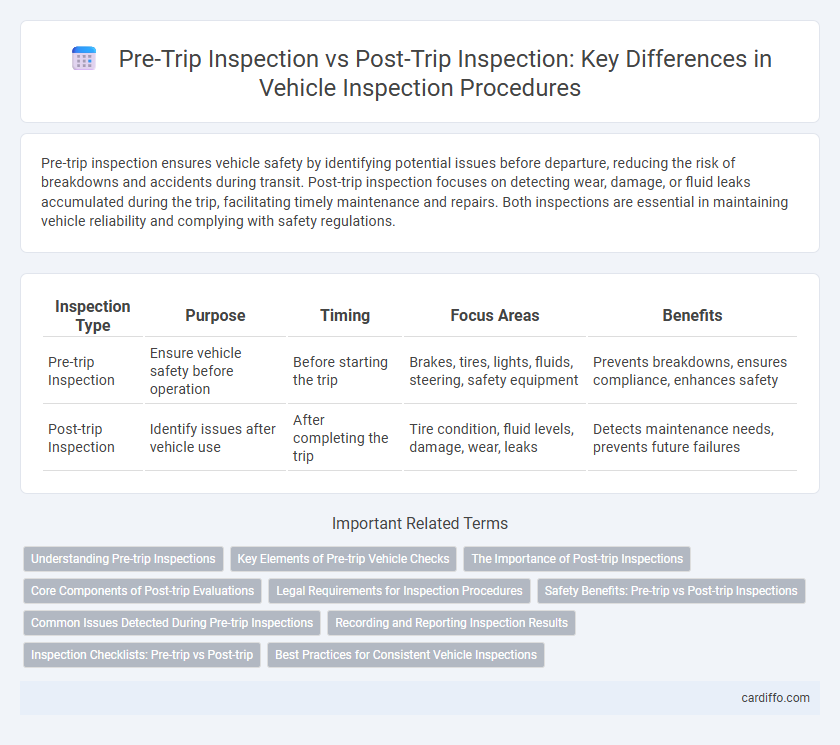Pre-trip inspection ensures vehicle safety by identifying potential issues before departure, reducing the risk of breakdowns and accidents during transit. Post-trip inspection focuses on detecting wear, damage, or fluid leaks accumulated during the trip, facilitating timely maintenance and repairs. Both inspections are essential in maintaining vehicle reliability and complying with safety regulations.
Table of Comparison
| Inspection Type | Purpose | Timing | Focus Areas | Benefits |
|---|---|---|---|---|
| Pre-trip Inspection | Ensure vehicle safety before operation | Before starting the trip | Brakes, tires, lights, fluids, steering, safety equipment | Prevents breakdowns, ensures compliance, enhances safety |
| Post-trip Inspection | Identify issues after vehicle use | After completing the trip | Tire condition, fluid levels, damage, wear, leaks | Detects maintenance needs, prevents future failures |
Understanding Pre-trip Inspections
Pre-trip inspections are essential for ensuring vehicle safety before operation by checking critical components such as brakes, tires, lights, and fluid levels. These inspections help identify potential mechanical issues that could cause breakdowns or accidents during transit. Understanding the specific checklist items and procedures for pre-trip inspections enhances driver compliance with safety regulations and reduces the risk of costly repairs.
Key Elements of Pre-trip Vehicle Checks
Pre-trip vehicle inspections focus on verifying critical safety components such as brakes, tires, lights, and fluid levels to ensure roadworthiness before departure. Inspectors assess the condition of seat belts, mirrors, horn functionality, and steering mechanisms to prevent violations and accidents. Comprehensive documentation of these checks supports regulatory compliance and helps identify defects early, minimizing downtime and costly repairs.
The Importance of Post-trip Inspections
Post-trip inspections identify wear, damage, or mechanical issues incurred during the journey, ensuring timely maintenance and preventing potential breakdowns. This crucial step helps maintain vehicle safety, extend equipment lifespan, and comply with regulatory requirements. Consistent post-trip inspections reduce costly repairs and improve overall fleet performance.
Core Components of Post-trip Evaluations
Post-trip inspections prioritize evaluating core components such as the braking system, tire conditions, and fluid levels to ensure vehicle safety and performance after operation. These inspections focus on identifying wear, leaks, and damages that may have occurred during transit, enabling timely maintenance and preventing future breakdowns. Emphasizing thorough post-trip evaluations helps maintain regulatory compliance and enhances overall fleet reliability.
Legal Requirements for Inspection Procedures
Pre-trip inspections are legally mandated to identify and address safety issues before a vehicle begins operation, ensuring compliance with federal and state regulations. Post-trip inspections are required to detect and document any defects or damages incurred during transit, facilitating timely repairs and maintaining operational safety standards. Failure to perform thorough pre- and post-trip inspections can result in legal penalties, fines, and increased liability in the event of accidents or regulatory audits.
Safety Benefits: Pre-trip vs Post-trip Inspections
Pre-trip inspections identify potential vehicle defects before operation, reducing the risk of accidents and breakdowns during travel. Post-trip inspections ensure any issues encountered during the trip are promptly addressed to maintain ongoing vehicle safety and compliance. Together, these inspections create a comprehensive safety protocol that minimizes hazards and promotes vehicle reliability.
Common Issues Detected During Pre-trip Inspections
Pre-trip inspections commonly detect issues such as tire pressure abnormalities, brake system malfunctions, and fluid leaks which can compromise vehicle safety and performance. Inspectors often find faulty lights, damaged mirrors, and windshield cracks that may not be visible during post-trip checks after the vehicle has been operated. Identifying these defects before departure ensures compliance with safety regulations and reduces the risk of breakdowns or accidents on the road.
Recording and Reporting Inspection Results
Pre-trip inspections require detailed recording of vehicle conditions before departure to ensure safety compliance and prevent mechanical failures during transit. Post-trip inspections focus on documenting any new damages or issues encountered, facilitating timely repairs and maintaining accurate maintenance records. Both inspection reports play a crucial role in regulatory adherence, risk management, and fleet operational efficiency.
Inspection Checklists: Pre-trip vs Post-trip
Inspection checklists for pre-trip and post-trip inspections are crucial for vehicle safety and regulatory compliance. Pre-trip inspection checklists focus on identifying potential hazards before departure, including checking tire pressure, brake functionality, lights, and fluid levels. Post-trip checklists emphasize detecting damage or wear incurred during the trip, such as inspecting for leaks, tire wear, and any mechanical issues that need repair before the next journey.
Best Practices for Consistent Vehicle Inspections
Pre-trip inspections focus on identifying safety issues before the vehicle is operated, ensuring tires, brakes, lights, and fluid levels meet standards to prevent breakdowns and accidents. Post-trip inspections document any wear or emerging problems after use, enabling timely maintenance and reducing long-term repair costs. Consistently applying detailed checklists and using digital inspection tools enhance accuracy and accountability in both pre-trip and post-trip vehicle inspections.
Pre-trip Inspection vs Post-trip Inspection Infographic

 cardiffo.com
cardiffo.com